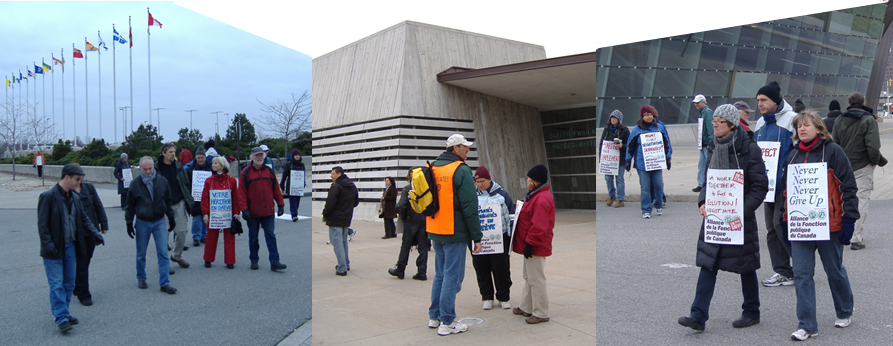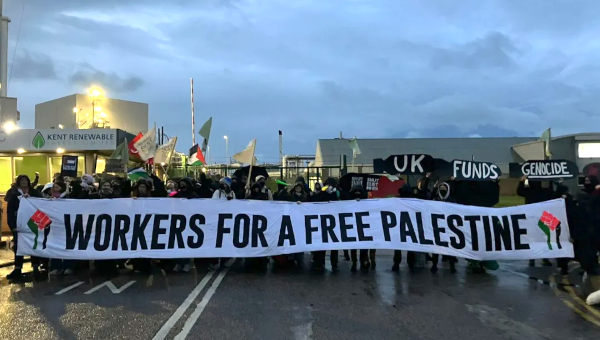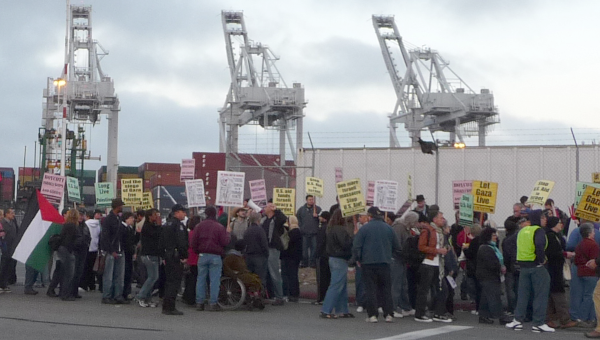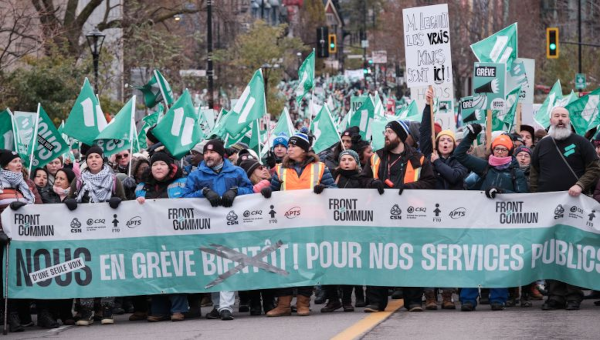Museum Workers at War
Precarious Employment and the Public Sector Squeeze
The casualization of labour has placed many workers in a position of precariousness forcing them into a state of perpetual insecurity characteristic of the ‘new economy’ neoliberal nightmare. In an effort to reduce production costs and maximize profitability, many employers have adopted a neoliberal approach to employment, which is achieved through the temporary and discretional use of labour, major layoffs, the retrenchment of wages, workplace intensification and the denial of benefits. The result of which has brought real wages to a near stand-still over the past twenty-years, as well as a growing chasm between worker productivity and the compensation that follows.
The battle for wage parity and job security rages on in Ottawa between the Canadian Museum of Civilization Corporation (CMCC), which operates both the Canadian Museum of Civilization and Museum of War, and the 92% of fed up workers who voted in favour of a strike. The current strike by 420 Public Service Alliance of Canada (PSAC) members is the longest running labour strike in PSAC history. The workers have been on strike for more than 60 days after initial attempts to bargain for a fair collective agreement came to a halt on September 18th of this year.
The Museum and Casual Workers
With the private sector setting the standard for wages, casual labour and precarious working conditions have become the norm in strategies to reduce labour costs. The neoliberal policies and employment practices of the CMCC have been receiving growing attention since the beginning of the strike. Employees of both museums have suffered from intensified fiscal and austerity measures by the crown corporation with a remarkable 38% of the total number of CMCC workers hired on contractual and temporary basis. The problem is not a lack of available positions, but jobs that could be given to PSAC members have instead been consistently offered only to outside contracts without union representation. In fighting to end the casualization of labour at the museums, job security has become a sticking point in the negotiations rather than, as frequently depicted in the mainstream media, wages. For instance, at present there are only six permanent tour guides at both museums. There are, however, 49 positions which remain temporary and part-time which translates into a casual employment rate of nearly 90%.
The casualization of labour strips workers not only of benefits, but also robs them of the potential for advancement. Due to the contracting out of positions, employees of the museums are denied recognition of dedicated service and, in some cases, years of valuable experience. Unfair labour practices such as this are sadly becoming increasingly typical. Once entered into it is extremely difficult to break out of the precarious employment cycle. The fear of unemployment increases as unemployment benefits are reduced and severance packages avoided entirely. The financial insecurity this creates pressures employees to continue to accept temporary contracts, which lowers the chances of securing a permanent job. For example, many of the temporary workers at both museums work with the public as hosts, tour guides, and animators.
Under the guise of the economic crisis, the employer has sought to place workers in competition with each other, which is clearly noticeable in the wild differences in pay among workers in similar positions of employment. CMCC employees make anywhere from 20-40% less than others occupying the same or very similar positions requiring the same training and expertise at other federal government museums. For example, a host working at the Museum of War is given an hourly wage of $13 while the same host would be paid $24 at the Museum of Nature. Yet, the federal government awards the CMCC with more funding than any other comparable federal institution in the region. Workers continue to demand wage parity with other museums and access to benefits.
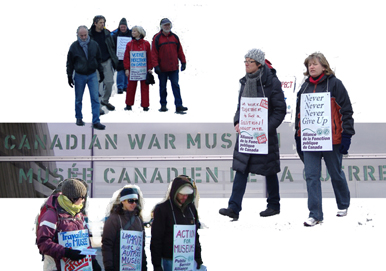
The CMCC has a system of terminating temporary positions days before they reach the level at which they become eligible for a permanent position as stated by the collective agreement. They then enforce a three-week waiting period after which the former employee may receive a new offer of employment. The newly re-hired worker is forced to start again at the bottom of the pay scale without any seniority. The only exception in the refusal to consider seniority is during the scheduling of vacations. However, where lay-offs and promotions are concerned managers possess the power to terminate contracts at their discretion. One such termination involved an employee who had 20 years of employment experience with the CMCC.
Also, when the opportunity to acquire a permanent position does become available years of service does not make a difference for the internal hiring of such positions. A case in point is a guide employed by the CMCC for more than eight years on a ‘temporary’ basis interviewed for a permanent position twice that in the end went to a less-experienced employee. Other workers have been with the CMCC for 19 years and more who are still considered temporary by the corporation. These practices are outrageous and cannot be tolerated. They are also perfect examples of the neoliberalization of the workplace, increasing worker insecurity and precariousness. The workers have made it clear that they are not backing down on job security, while the employer refuses to implement protections that would end this perpetual term-based employment and contracting out.
One of the ways the corporation has avoided providing benefits is through interim positions in which an employee may receive an increase in wage, for example as an acting supervisor, but because they do not officially hold their position they are not eligible for benefits. The corporation is also looking to reduce benefits already in place with respect to the requirements for sick pay and vacation leave eligibility, which would increase the six month probationary period employees must complete before acquiring access to such benefits to one full year. With proposals such as this demonstrating the ‘good faith’ of the corporation in bargaining there is no end in sight to the strike.
Strike Support for Museum Workers
Workers continue to walk the picket line every day, gaining public support and political attention, and demanding the respect and recognition they deserve as an integral part of both museums. Unions affiliated with PSAC have come forward in support of the strike, such as the Professional Institute of Public Service along with its 57,000 members. Also, the Canadian Labour Congress (CLC) recently met in Ottawa and agreed that the CMCC “has blatantly abandoned that responsibility by failing to negotiate a fair collective agreement.” It is now urging its 3.2 million union members across the country to boycott the museums until this labour dispute is satisfactorily resolved. It is also asking the Canadian government for a public showing of support for the employees in their struggle by applying pressure to the CMCC, and in particular the Museum CEO Victor Rabinovitch, to begin taking negotiations seriously and work with workers to end precarious employment at the museums. While public shows of support, along with letter-writing efforts, visits to the picket line, and other actions, are important and appreciated, winning the fight against increasing precarious employment trends now requires both union and labour councils to collarborate on a wider scope of tactics. As such, in order to maximize the power of labour and address larger systemic political issues, it is essential that the CLC, along with the Ottawa & District Labour Council or the Ontario Federation of Labour, work together to develop coordinated bargaining strategies whenever possible.
Efforts by the employer continue to promote an anti-union sentiment as oppressive bullying tactics are used to lower morale and strip workers of their bargaining power. In lieu of negotiating, the CMCC has preferred engaging in censorship and intimidation. For instance, PSAC was presented with a letter from CMCC’s legal counsel threatening that immediate action would be taken if so-called defamatory comments and photos were not deleted from a Facebook page set up to provide strike support entitled “Fairness and Justice for Museum Workers.” PSAC responded by saying that they are not of the opinion that the material on this page is offensive or inaccurate and accused the corporation of attempting to suppress the voice of the workers and their freedom to expose the unfair work practices they have endured and share their experiences. Maria Fitzpatrick, the Regional Executive Vice-President for the National Capital Region described this attempt at censorship as “acts of desperation” and went on the say that “we are appalled that a Crown corporation is spending taxpayers’ money to attempt to intimidate workers into silence, rather than getting back to the bargaining table to negotiate a fair settlement.”
However, PSAC is proving itself a force with which to be reckoned in their counter-attack by presenting the CMCC with a letter of their own in reference to a web publication entitled “Union Activities Counterproductive to Negotiations.” In an attempt to sway public support away from the strikers, the CMCC document states: “The Public Service Alliance of Canada and some of the strikers have taken their labour dispute from the work site to the private residences of employees of the Canadian Museum of Civilization Corporation. These employees, their spouses and children were frightened, and felt intimidated and harassed by these questionable tactics. We believe that the majority of striking staff and Canadian citizens would find such activities reprehensible and not conducive to a timely resolution of the current labour dispute.” The “reprehensible” activity in question was a pancake breakfast, which PSAC describes as “in no way intimidating, frightening, harassing or otherwise improper or questionable.” If the corporation refuses to remove the document PSAC is ready to pursue legal action for damages and sue for defamation on grounds of its own.
This would not be the first time that CEO Rabinovitch has faced the threat of legal action and protest. However, he has proven far more accommodating in his past concessions. In 2001, fearing negative public relations he quickly pulled an exhibit of Arab-Canadian art at the National Gallery shortly following the events of September 11. This racist move was reprimanded, with a slight slap on the wrist from Parliament and the reinstatement of the exhibit. He also found himself in hot water after yielding to a veterans’ lobby group with respect to a WWII exhibit at the Museum of War. The group claimed the exhibit was disrespectful in its representation of the numbers of German civilian deaths incurred as a result of allied bombing. This lack of integrity has reached a new high as Rabinovitch and the Museum’s bargaining committee continues to refuse addressing workplace insecurity, staffing procedure, and wage disparities. Nearly two thousand postcards have been signed by museum patrons asking that the labour dispute be settled fairly. Rabinovitch does not seem as concerned with public relations this time around as he persistently refuses to acknowledge public support for the strikers – an irony not lost on the strikers.
Intimidating Workers
Intimidation tactics and harassment now seem to be the CMCC’s way of forcing a resolution to the strike. Records of Employment have been sent to the homes of those on strike without explanation. This is a rather bold move on behalf of the corporation’s anti-union strategy. PSAC has not taken kindly to such tactics and indicated that their lawyers will be demanding an explanation for this latest offensive. This is the first time an employer has ever sent such documents to the homes of striking employees in the 43 years the union has existed. PSAC has reassured its members that there was no legal cause for the sending out of such documents and advised them to ignore the Records of Employment. PSAC has reminded management that “Section 94 of the Canada Labour Code clearly states that no employer may terminate, layoff, discipline, transfer, suspend, intimidate, threaten or otherwise discriminate against an employee for participating in a legal strike” and threatening to do so will result in charges of unfair labour practices. Also, private security surveillance has been subcontracted by the CMCC to constantly videotape the strikers, at times from only a few feet away.
Despite the corporation’s attempts to scare workers into concession and forcefully impose upon them a permanent state of precariousness, the workers have stood their ground. Strong bonds have been formed while picketing and morale continues to be positive as workers are anxious for talks to resume. Many strikers express support from the public and stress that the dispute is not with the public, but with the CMCC. Ralph Brassard, a strike captain with PSAC, stated from the picket line, “We’ve been saying all along we are willing to go back to work, but what will the relationship be? It’s not about the money, it’s about security.” Seeking to avoid arbitration the corporation agreed to meet with the union on Friday November 20th. Instead of accepting the union’s offer to resume negotiations over the weekend, stalling tactics on behalf of the CMCC have pushed talks to later in the week by requesting to review once more the written demands of the workers, which have not changed since they were first laid out nine weeks ago. Although the PSAC bargaining unit is frustrated, it has indicated that this only increases the union’s dedication to obtain a fair collective agreement.
Public Sector Contracting-Out and Precarious Work
The actions leading up to and taking place during the current PSAC strike illustrate how increasing trends in non-standard, temporary, private work practices such as those endured by CMCC employees, are presenting collective bargaining with many new challenges. The stage upon which unions engage in collective negotiations with employers is no longer set the same way. The ongoing contracting out of public sector positions to private firms within federal institutions is indicative of the massive federal cuts to cultural spending by the Conservative government. Melissa Ferland of PSAC states: “This is a frightening time in which people who have full-time, permanent status still feel they could be laid off or replaced by a private firm at any time. It’s incredibly difficult on the psyche.”
The National Gallery of Canada recently handed its boutique over to a private company resulting in the dismissal of nine employees. This has come after educators and guides employed at the Gallery received a letter referring to them as “surplus” and an additional 12 people were laid off in early September of this year. PSAC has since filed grievances against the employer and described “the lay-offs and the manner in which they were conducted clearly violate the collective agreement.”
The collective agreement between the Gallery and PSAC is set to expire in June of 2010. PSAC represents over 166,000 Canadian workers, many from the federal public sector. In preparation of future labour disputes, their efforts in achieving job security and fair wages for its members involved in the current strike is crucial in setting precedent as a win in the battle against precarious work. •
Resources
- Facebook: Fairness and Justice for Museum Workers
- Youtube: CivilizedWorkers
- PSAC petition: Send the museum dispute to arbitration
